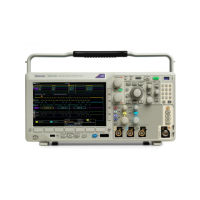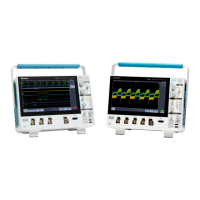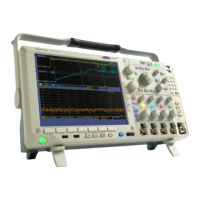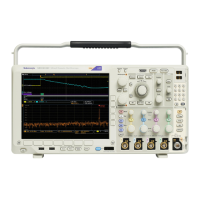Commands Listed in Alphabetical Order
CH<x>:BANdwi
dth
This command specifies the selectable low-pass bandwidth limit filter for channel
<x>, where x is the channel number (1–4).
Available bandwidth limits vary by model, and are also influenced by attached
probes. Furthermore, some oscilloscope models support options to increase
the analog bandwidth. The presence of those options also affects the available
bandwidth limits.
To see what the available bandwidth limits are, on the UI, push the relevant
channel's front panel button and the push the Bandwidth lower menu button, and
see what bandwidths are listed in the side menu.
Group
Vertical
Syntax
CH<x>:BANdwidth {FULl|<NR3>}
CH<x>:BANdwidth?
Arguments
FULl disables any optional bandwidth limiting. The specified channel operates
at its maximum attainable bandwidth.
<NR3> is a double-precision ASCII string. The oscilloscope rounds this value to
an available bandwidth using geometric rounding, and then uses this value to
set the upper bandwidth limit.
Examples
CH1:BANDWIDTH 20E6 sets the bandwidth of channel 1 to 20 MHz.
CH<x>:COUPling
This command specifies the input attenuator coupling setting for channel <x>,
where x is the channel number (1–4).
Group
Vertical
Syntax
CH<x>:COUPling {AC|DC|DCREJect}
CH<x>:COUPling?
Arguments
AC sets channel <x> to AC coupling.
DC sets channel <x> to DC coupling.
DCREJect sets channel <x> to DC Reject coupling when a probe that supports
DC Reject coupling is attached. Attempting to set the coupling to DCREJect for a
MDO4000/B/C, MSO/DPO4000B and MDO3000 Series Oscilloscopes Programmer Manual 2-221

